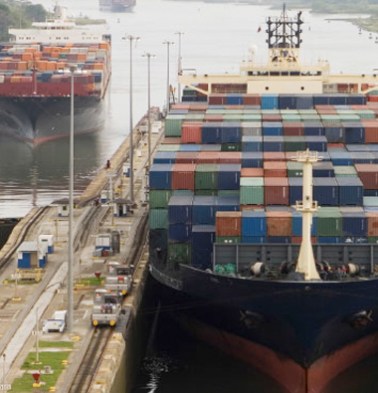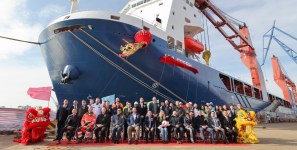TERMINAL CAPACITY
Will East and Gulf Coast Ports Be Ready to Accommodate Post-Panamax Ships?
Preparing for an expanded Panama Canal means far more for U.S. ports than having 50-foot-deep channels at a handful of maritime facilities.
The $6 billion expansion project, which began in 2007, initially was slated for completion in 2014—the 100-year anniversary of the canal’s original opening—but there have been multiple delays, with expectations now that the endeavor will be finished sometime in the second half of 2015.
Will that be enough time for East and Gulf Coast ports and related infrastructure to be ready to handle larger ships and increased cargo volumes?
“I hope they can open it up in 2015, because we don’t want to keep talking about it,” says port economist Dr. John C. Martin, president of Lancaster, Pa.-based Martin Associates, who opines, “We are not ready on the East Coast and the Gulf Coast to handle the bigger ships that are coming.”
There are a few exceptions.
The Port of Virginia’s channel has been ready for years, with its 50-foot project having been finished in 2006.
“Our investment has been made and we are ready,” says Joe Harris, media relations manager for the Virginia Port Authority, who notes that for nearly three years Virginia facilities have been handling ships with capacities of more than 9,000 20-foot-equivalent unit (TEU) containers coming from Asia via the Suez Canal. That’s the size ship that will soon be able to ply all-water routes via the Panama Canal.
“Right now, we’re just polishing things,” Harris adds, citing an emphasis on preparing rail operations to handle greater volumes.
“We think we’re in a real advantageous position for the next five to seven years,” Harris says. “We think we can make some real hay.”
Florida’s ports have been getting significant state funding support as the Sunshine State is on the cusp of eclipsing New York to become the third-most-populous U.S. state. Florida’s maritime community has long grumbled that most goods flowing into the state enter U.S. soil via seaports to the north of Florida and are then railed or trucked southward to meet the needs of some 20 million residents and 90 million annual visitors.
PortMiami, Florida’s southernmost containerport, is joining with state, federal and private-sector partners to invest more than $2 billion in infrastructure improvements that include a 50-foot “Deep Dredge” channel project; a tunnel link between the island seaport and the interstate highway system; four more super-post-Panamax cranes; and restoration of on-dock rail service, with all upgrades either in place or slated for completion by late 2015.
“PortMiami is in transition,” says PortMiami director Bill Johnson. “The Deep Dredge will make PortMiami the only U.S. port south of Norfolk that can accommodate the new mega-cargo vessels that will pass through the expanded Panama Canal. We will be big-ship ready!”
Other Florida Atlantic ports are gearing up, too, with South Florida’s Port Everglades advancing channel and berth projects, the Port of Jacksonville focused on getting a 47-foot-deep channel and, perhaps most aggressively, Central Florida’s Port Canaveral proposing to have in place by 2020 a 55-foot-deep channel with an accompanying automated container terminal.
In May, the Port of Baltimore pronounced its readiness with the Maryland Port Administration’s opening of a 50-foot-deep berth, in conjunction with private partners. Port Authority of New York & New Jersey officials are confident their 50-foot project will be finished before the end of 2014, while an undertaking to raise the Bayonne Bridge roadbed to allow larger containerships to reach key New York and New Jersey terminals isn’t set to be done until 2015.
Port leaders are looking to Congress for passage of water resources legislation that will provide the authorization and funding framework for numerous additional channel projects, including at the Port of Savannah and others on East and Gulf coasts.
“The investment of more than $100 million a year in terminal improvements to increase capacity and improve efficiency, coupled with the imminent construction of Savannah’s harbor-deepening project, is a signal to the international shipping community that Georgia is moving in concert with the Panama Canal expansion as the gateway for trade to the Southeast United States,” says Curtis Foltz, executive director of the Georgia Ports Authority.
That still means only a handful of East and Gulf Coast ports will have deep enough channels to accommodate the largest super-post-Panamax containerships, but Lori A. Baer, former executive director of the Port of Palm Beach, Fla., and now vice president for South Region ports and marine at Los Angeles-based AECOM Technology Corp., points out that it’s not only those ports with 50-foot channels that should see benefits.
“All ports are gearing up and will be prepared for some level of increased trade from the Panama Canal,” Baer says. “Some ports are indeed ready to accommodate much-larger-sized vessels, but it is important to keep in mind the preparation must focus just as much on accommodating moderate-size vessels that may cascade to more and different ports.
“So the great majority of our ports are ready, with projects completed or well along for increased berth capacity, new cranes and operating equipment, as well as enhanced backland,” adds Baer.
While 18 East Coast ports will be competing for additional cargo, only four Gulf Coast ports—those of Houston, New Orleans, Mobile and Tampa—will be fighting for the increased throughput, according to Matthew Gresham, director of External Affairs at the Port of New Orleans, where new cranes, expanded marshaling yards and an intermodal terminal are among major projects.
Richard Steinke, who served 14 years as executive director of the Port of Long Beach, Calif., before becoming ports practice leader at Long Beach-based planning and design firm Moffatt & Nichol, emphasizes that deeper channels—which, as a matter of nature, are more prevalent on the West Coast—are just a part of preparation.
“I think the one thing that sometimes gets overlooked by many is that with the bigger ships comes more volume,” Steinke says. “And the larger volumes have to be handled in an efficient and productive way in those marine terminals.
“Having more volume puts more stress on the landside infrastructure,” he continues. “The cranes have to be higher to accommodate additional stacks of containers on a containership. The yard equipment needs to move more containers through that facility in a more productive manner, and, to the extent that there is discretionary cargo going to other parts of the United States from the port, a more developed intermodal yard with good connections with the hinterland also needs to be developed.
“It’s not just a waterside issue,” Steinke adds. “It’s a systematic issue relative to goods movement that needs to be focused upon. Whether it’s West Coast ports that are going to be seeing the likes of a 14,000- or 15,000- or 18,000-TEU ship or East Coast ports that are going to be seeing the 8,000-, 9,000- and 10,000-TEU ships, optimizing landside dynamics is still going to be very, very important.”
Development of better intermodal connections inland from East Coast and Gulf Coast ports may be seen in the building of enhanced roadway links and, on the rail side, in construction of on-port intermodal container-transfer facilities and in the advancement via public-private partnerships of corridors capable of handling long trains with double-stacked containers.
These high-clearance corridors include two Norfolk Southern Corp. projects—the Heartland Corridor from the Port of Virginia to Chicago and the Crescent Corridor from New Orleans to New Jersey—and CSX Corp.’s National Gateway through North Carolina, Virginia, Maryland, Pennsylvania, West Virginia and Ohio.
The rail projects are critical to the equation as to at what point in the Midwest it becomes more cost-effective to bring cargo via East Coast or Gulf Coast ports as opposed to through West Coast gateways that have long handled more than 40 percent of the nation’s imported goods, most of which head inland on rails of BNSF Railway Co. and Union Pacific Railroad. Some experts suggest that line is in Ohio, while others say it may move as far west as St. Louis.
As port economist Martin puts it, “The Midwest becomes the battleground.”
It shouldn’t be overlooked that Vice President Joe Biden, in a Nov. 6 visit to the National Gateway hub in North Baltimore, Ohio, said the CSX project is “the inland version of widening the Panama Canal.”
Whereas the canal project has been getting most of the attention and credit, Kurt Nagle, president and chief executive officer of the American Association of Port Authorities, is quick to note that overall competitiveness is as much a reason behind the enhancement of port facilities throughout the Western Hemisphere as the expansion of the Big Ditch.
“While the Panama Canal expansion may be one of the factors attributed to the more than $9 billion a year of port-authority and private-sector investment in America’s seaport infrastructure, Panama itself is undertaking the canal expansion to maintain its competitiveness due to global trade growth, increasing vessel sizes in the world fleet, dynamic trading patterns and other factors,” Nagle says.
“Similar big-ticket infrastructure projects,” Nagle continues, “are also planned or under way elsewhere in the Western Hemisphere, such as Brazil, Canada and Mexico, which have formulated national infrastructure programs and policies and are investing heavily into everything from their ports to their power plants.”
CARGO BOOSTS WON’T NECESSARILY BE IMMEDIATE
Just because enhanced harbor depths and expanded container terminal facilities won’t be ready at but a few U.S. East and Gulf coast ports when the widened Panama Canal opens, optimism about future cargo volume increases abounds in places such as Charleston, S.C.
Although the Panama Canal project is now targeted for late 2015 completion, the deepening of Charleston Harbor is not anticipated to be done until 2018, the same year the South Carolina Ports Authority is slated to open a new 288-acre container terminal on a former U.S. Navy base site in North Charleston.
“I’d say 2018 will be a really big year for South Carolina Ports,” says Jim Newsome, president and chief executive officer of the South Carolina Ports Authority.
Charleston’s main shipping channel presently is maintained at 45-foot depth, although some deeper-draft vessels—requiring as many as 48 feet—are able to access port terminals during hours when a significant tidal lift provides a boost.
A key Charleston Harbor report from the U.S. Army Corps of Engineers is scheduled to be released by late summer 2015, and South Carolina officials remain confident that, thanks in part to a state legislative set-aside of $300 million, the deepening to 50 feet should be able to proceed swiftly after final federal approvals.
The Palmetto State authority already is geared up to move greater volumes inland, thanks to the October opening of the 91-acre South Carolina Inland Port at Greer, linked to the Port of Charleston by 212 miles of Norfolk Southern Railway main line as well as a couple hundred miles of Interstate highway.





Leave a Reply